Study Trip to Armenia 2009
This post was reinstated on the redesigned tgm website in January 2024. – Michi Bundscherer
14 DEC 09 – Enchanted by Armenia
After having returned to Munich I thought: What a great trip, I have been a member of a wonderful travelling party and I have had the pleasure and the honour of enjoying the best travel-guide in the world. My stay in Armenia was impressive and interesting, but at first I didn’t feel I wanted to return to the country as soon as possible.

How do I feel now, four weeks later? Well, I have to confess that thoughts and feelings have changed. Changed quite considerably. I am not yet willing to admit that I am enchanted by Armenia, but I think I am gradually becoming aware of a peculiarly sustainable Armenian spirituality – a spirituality which is an effect of the landscapes we have seen, of the people we have met and of the music we have frequently listened to. In short, I am rather certain now that I will return to Armenia someday to leisurely visit the places of my memories again. There still is so much to discover.
A little digression: in principle, Bach, Haydn, Mozart, Beethoven, and many others had Armenian ancestors! If music historians tackled the problem properly, they would soon find Armenian roots in each of them. At least on the mother’s side in the third or fourth generation. I am absolutely convinced that Armenian scholars in the field of music history must by now have come to convincing conclusions in this regard. In only a few days, I took a liking to Armenia and its people, who are incredibly patriotic. Not only are they proud of their own historical achievements, but in boundless generosity, they are ready to embrace other cultural heroes and major historical events in the East and West as part of their own cultural heritage. This is definitely impressive. At least with me. And has quite a lasting positive effect.
As mentioned above, this is an ongoing process which has only just begun. On 7th November 2009, to be precise.
11 December 2009, Christoph Höfer
Note: On the one hand, this is an ironic reference to the Radio Yerevan jokes that were very popular in the Soviet Union („In principle, yes …“); on the other hand, this refers to the tendencies in many Armenians to find an Armenian influence in „positive“ historical events.
Radio Yerevan was asked: ”Is it possible to read Mao’s sayings in the USSR?“ ”In principle, yes, but only in the original.“
Radio Yerevan was asked: ”May party leaders be criticized by ordinary party members?“ ”In principle, yes, but that would be a real pity.“

9 NOV 09 – Diary of the trip’s preparation
May 2008, Istanbul: the tgm travelling party is having dinner. Some members suggest a journey to Armenia. I am quite please by the idea and offer to organise the trip for the tgm – without having the slightest clue what this really means.
June 2008, Munich: the tgm’s active team hold their monthly meeting. The proposal to travel to Armenia meets with general approval.
October 2008: only shortly after announcing the trip to Armenia, the first members make advance reservations! Although I am right in the middle of the preparations, I do not really expect that the minimum number of reservation will be achieved.
April 2009: the tgm holds a meeting on Armenia. Monique Laruelle has prepared some Armenia dishes and is excited about this cuisine which she has only just discovered. Gerayer Koutcharian comes down from Berlin and gives the participants a little introduction to Armenia’s culture.
9 May 2009: the tgm shows Atom Egoyan’s movie “Ararat” which afterwards sparks a lively discussion – despite difficult and partly incomprehensible (Canadian English) dialogues
18 May 2009: the trip is sold out!
July 2009, Yerevan: family reunion. A good occasion to make a reservation for the hotel which I can inspect on the spot instead of having to rely on the promising descriptions in the Internet. The enormous heat (more than 40° Celsius), however, prevents me to organize anything else. Besides, I only have four days.
September to 23 October 2009: my phone is never quiet. Over and over again, I have to ask my family in Armenia to collect information, and I am in constant exchange with colleagues, especially with Edik Ghabuzyan, a type designer located in Yerevan, who is very excited about German typographers and people interested in typography come to Armenia to discover its culture and his works and that of his colleagues.
24 October to 31 October 2009, Yerevan: three to four appointments daily (meeting colleagues, preparing guided tours in German through various museums, restaurant testing, looking for concerts, translators, guides, reliable transportation and so on). On the evening prior to the arrival of the travellers I have at least managed to set up and book a complete programme for the next five days. For the last two days, there are two meetings scheduled, but not confirmed. The Armenians don’t quite understand why one should commit oneself a week or even ten days in advance. (“Let’s phone on the night before …”) I design a simple programme and have it printed in the most incredible copy-shop I have ever seen, when the phone rings: the first change of schedule. The minister of culture would like to receive our travelling party already on Monday, not as planned on Wednesday …
7 November 2009: we are back home. Mine was the most delightful travelling party a tour guide can wish for. People who embraced me after an unbearable concert and comforted me: “Come on, relax, everything is fine.” Thank you for that! And thank you for interest in the beauty of “my” country and not minding its shortcomings – which is more than I manage to do.
Thanks also to everyone who has supported me in my exciting task. Thank you, Tessa Hofmann, for your essay in the tgm’s spring/summer 2009 programme. Thank you, Gerayer Koutcharian, for your introduction to Armenia in the spring of 2009. Thank you, Edik Ghabuzyan, for your motivation, your open-mindedness and your great support during the trip. Thank you, Marina Dietweger, for the wonderful teamwork. And thank you, tgm, for providing me with the opportunity to learn so much about my roots and the country of my ancestors.
Saturday, 7 November 2009, Catherine Avak
9 NOV 09
Departure: fingerprints in Armenia and working at night.
3 a.m. We all met at the bus on time. The hotel almost managed to stop our departure, because they had not yet checked all the mini-bars in our hotel rooms. Our chairman, however, managed to solve the problem quite coolly, as he always does.
A last view of Mount Ararat:

The security check at the airport required all of us to give our fingerprints, irrespective of the age of our passports. Will our identities be stored forever, to be retrieved whenever it crosses somebody’s mind. Or are they going to be junk data, soon to be deleted? We probably will never know.
Waiting in the cafeteria. For some of us, it’s early morning, for others late in the evening, depending on the choice of drinks (coffee or red wine). We w ere also busy updating this blog, later also in the Vienna airport where we arrived after a three hours flight at 6 a.m. and had to wait another three hours for our connecting flight to Munich.
What a great trip! So rich in wonderful impressions and experiences – we will be busy for some time to let everything sink in. During my first night at home, I (Ulrike) dreamt that I was able to play the Duduk like a professional. And by now, I have actually managed to produce a note on it (once)!
As a last farewell to Armenia, to Hayastan, as the country is called in Armenian, the beautiful poem by Yeghishe Charents, which Hakob recited for us.
My Armenia
The taste of the sun in the language of my Armenia, I love,
The moving, mourning string of our dear old saz, I love,
The scent of blood-red flowers and roses I love,
And the graceful round dance of girls of Nairi, I love.
I love the blue of our sky, the clear water and the lucent lake,
The summer sun and winter’s ferociously bellowing storms
The black walls of the old houses hidden in the dark,
And the thousand-year-old stones of ancient cities, I love.
Wherever I am, I will never forget the mournful tunes of our songs,
I will not forget our iron-script books turned into prayers,
However deep my heart is hurt by our bloody wounds,
my orphaned, sorrowful and adored Armenia I love forever.
For my heart, homesick and yearning there is no other tale,
There are no thoughts that matches that of Narekatsi’s and Kuchak’s,
Wander the world, yet there is no peak to surpass Mount Ararat,
The summit of Mount Ararat I love – like the path to unattainable fame.
(The original of “My Armenia” by Yeghishe Charents)

Schnorhakal em Catherine, schnorhakal em Hakob. Z-tesutjoon Hayastan!
Ulrike und Johannes Küster
8 NOV 09 – Thursday: from Mashots to Chatsha’atrjan
Visiting the linguist saint
The grave of the saint and linguist, that every Armenian schoolchild has to visit, is located in Oshakan. His name is Mesrop Mashots, and he created the Armenian alphabet in the 4th century. In the garden of letter sculptures, each of the holy signs is portrayed in an elaborate sculpture (the picture shows the Armenian letter T).

In an annex usually reserved for meetings of the “holy” translators, we saw an exhibition displaying entries of last year’s type design competition “Granschan”. The work shown here is by Edik Ghabuzyan, probably Armenia’s most interesting type designer.

The Armenian Designers Association
Some members of the tgm travelling party paid a visit to the Armenian Designers Association, represented by the current and former presidents. There was a design initiative already in the Soviet period, which is to be revived today. This could prove difficult, however, since present-day Armenia largely lacks the required industrial background. The president stated, however, that the number of design specialists and professionals to be represented by the association is considerable. Currently, around 400 members have joined the association. Yet up until now, there is hardly any further training or workshops for designers. The Designers Association, however, is heard in the negotiations on the curriculum of the technical schools, and the board of the association also provides teachers. Members of the association are required to have completed their professional training and must be experienced professionals. They are appointed by a committee on the basis of their works.
The smallest village church in Armenia or the entire world?
Karmawor, a sweet little village church dating back to the 7th century. Rain. Lovely old cross stones. Rain. An inscription frieze running all around the church. Rain.

More rain at the Saghmosavank Monastery, excitingly situated atop a beautiful, wildly romantic gorge. While Hakob goes hunting for the key to the church, we enjoy a wet view. Grateful to get inside where it is dry.


Opera
In the opera and philharmonic house, a “double building” inaugurated in 1937, we are surprised by Aram Khachaturian and his ballet “Gayane” (1942), which is usually known for the sabre dance only. A late expressionist, very colourful stage design (approved by the master himself), the orchestra quite okay, the ballet dancers were met with enthusiastic applause (Oh, to be dancer in Yerevan!). Nevertheless, the crowd incessantly telephoned and photographed

Thursday, 5 November 2009, Astrid Baldauf und Rudolf Paulus Gorbach
6 NOV 09 – On the road: landscape, clime









Wednesday, 4 November 2009, Pavlo Kochan
6 NOV 09 – Wednesday: Lake Sevan and Matenadaran
8:30 a.m. We are a little late, as usual, to depart for Lake Sevan. Now we have to hurry up, since we have to be back by noon, when we are to see the Armenian collection of manuscripts.
As our bus climbs into the Armenian mountains, behind us Mount Ararat can be seen for the first time. We are lucky, it is a sunny day. The further we go, the higher the mountains around us, some of which already have snow-covered peaks. On passing Sevan, the town that gave its name to Lake Sevan, we behold its landmark, a Ferris wheel, with only one gondola remaining – a sad relict from better times.
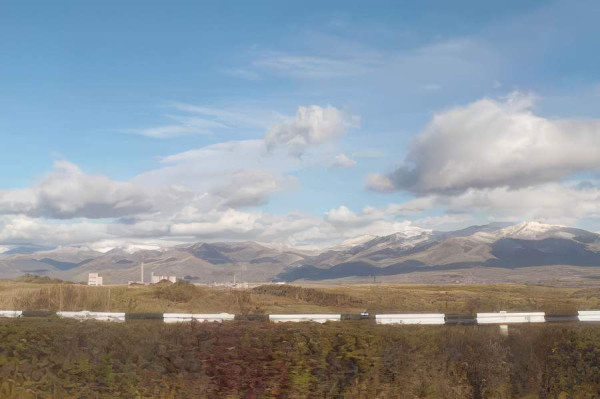
Before reaching the lakeshore, we drive round a little hill called daughter-in-law’s hill. The name is derived from a tale in which a daughter-in-law forgot to put a stone on the village well in order to seal it after taking some water. As a result, the fountain kept spouting and eventually caused a flooding which led to the formation of Lake Seven. The infuriated villagers cursed the woman for her negligence, and she turned to stone and became the hill mentioned.
Shortly afterwards we are on the shore road which must mark Lake Sevan’s former waterline. Approximately 1900m above sea level, the lake is one of the highest in the world. Today, it has shrunk by two thirds, due to the massive use of its waters in Soviet times, when several power plants were built along the tributaries of the lake to supply the country with energy. In the long run, this would have been disastrous for a region depending on potato farming and fishing.

From the lakeshore drive we turn into a little road that leads, via a pathway that in former times was submerged, to a monastery, which today is on a peninsula. The name comes from se van, meaning here (se) a monastery (van) is to be built. We climb 250 stairs to the three churches, two of which are still intact. The view is breathtaking, the lakeshore hardly visible. The locals are quite right to call it sea. The sky is overcast, with glimpses of sun. The atmosphere is bleak and gloomy, and very apt for this place with its dark and rather archaic churches.
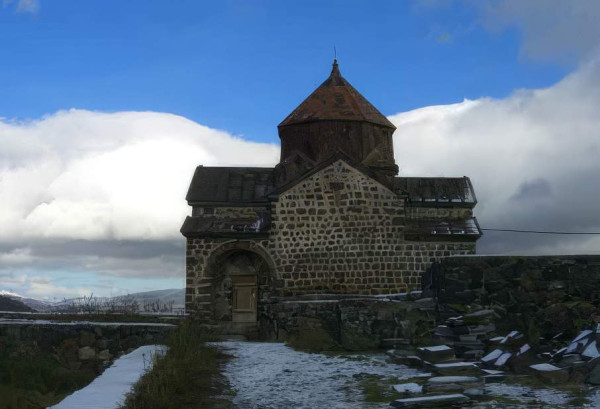
During a visit to one of the churches our guide Hakob shows us a 16th century cross stone depicting biblical scenes. The simplicity of these almost childlike representations is deeply moving. After a last stroll on the premises we are happy return to the bus. It is bitter cold, there is already some snow, and the wind-chill is just freezing.
On the way back, a brief stop gives us the opportunity to take a digitalized piece of Mount Ararat back home. After a little break in our hotel we are back on the bus and on our way to the Armenian collection of scriptures, the Matenadaran. With this magnificent building, located on a hill in the north of Yerevan, the Armenians have erected a real monument for their alphabet. Before entering the collection, which has grown in only a short period time from 5.000 to 17.000 exhibits, we enjoy a marvellous view of the city. Since the collection is being digitalized, it might soon be possible to view some of the treasures under matenadaran.am – maybe even today?

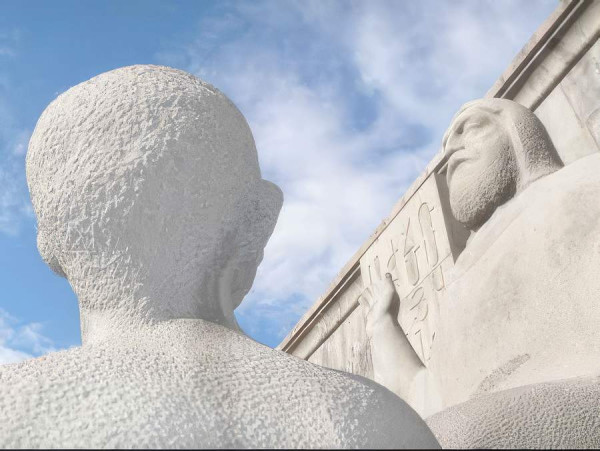
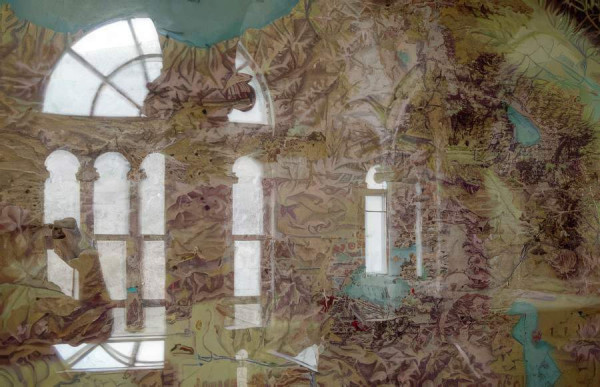




Guided by an expert, we are introduced to the most important exhibits, beginning at the time, when Mesrop Mashtots created the Armenian alphabet. He developed it in cooperation with a calligrapher in 405.
After the alphabet was completed, the first book to be translated was the Bible enabling the Armenians to read the Holy Scripture. This was of utmost importance, since religion greatly contributed to forming an identity for this people scattered all over the world – and it still does so today. The translation of the Bible was soon followed by other texts, mainly works by ancient Greek and Roman authors. This prevented some of the text from falling into oblivion, since their originals were lost in the Middle Ages. Here, many manuscripts on topics like philosophy, natural sciences, law and grammar as well as dictionaries can be found.
By the way, it is interesting to note that translators are held in high esteem in Armenia. This is illustrated by the remarking fact that only Armenia has an official Translators’ Day, a festivity dedicated exclusively to this profession.

A very special part of the exhibition is the presentation of the Armenian red, a dye used for miniatures and illuminations. It is derived from little insects that come out of the earth only once a year to breed. The recipe for the production of the dye was lost in the course of centuries, but after many experiments an inventive Matenadaran scientist succeeded to rediscover it so that it can again be produced today. This beautiful crimson red was highly sought-after in the past and does not fade even in centuries.
Some members of our group are even admitted into the sanctum of the collection, the repository, where they get to see some very special exhibits. The other doors of the institute, however, remain locked, as the permission to visit the rooms was withdrawn on short notice. What a pity!
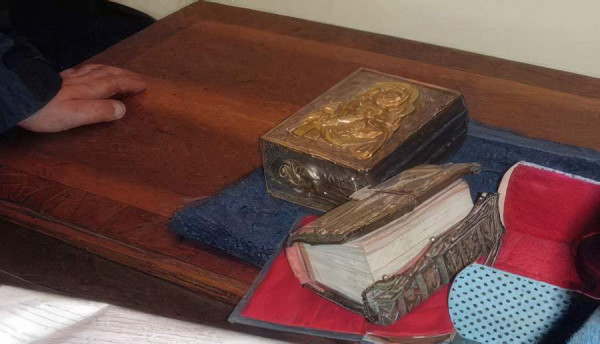
We have dinner in a restaurant dedicated to reviving the traditional Armenian cuisine. Here, the meals served are prepared after recipes almost forgotten, such as Ghapama, pumpkin stuffed with nuts, dried fruit and rice, doused with honey and baked in the oven for approximately six hours. A delicious treat, which we enjoy along with wine and Armenian live music. A little nightcap in the hotel bar rounds off a beautiful day.

Wednesday, 4 November 2009, evening, Angelika und Robert Iwen
5 NOV 09 – Back once again: to Sunday!
Yerevan, 14° Celsius, rain. At least, the hairstyle’s okay. And thankfully, we have had a good night’s sleep again instead of spending it on a plane. The daily challenge in the mornin g: getting breakfast from the buffet. The first critical situation arises, when there are neither coffee nor cutlery to be had. But we manage with instant coffee and dip the bread into the jam pots …
It’s Sunday, All Saints at that, and we are heading for Armenia’s religious centres. Our first stop, quite close to Yerevan: the charming St. Hripsime Church, one of the oldest in Armenia and dedicated to the patron saint of the same name. Like most martyrs, Saint Hripsime’s fate was rather appalling, especially since she was not only pious, but also pretty. Let’s hope she enjoys the beauty of her sarcophagus. A girl’s choir, all dressed in blue, accompany the beginning of mass, very impressive. The church is one of the first specimen of the architecture typical to Armenian sacral structures with longitudinal nicks in the supporting walls – to increase its stability in case of earthquakes.

… And we actually get to see the Catholicos entering … heralded by no less than one hundred priests and seminarians.
We go on to the spiritual centre of Armenia, Echmiadzin, seat of the Catholicos or head of the Armenian Apostolic Church. It is obviously a place to go for Armenian families. The bookshop offers, among other things, earth, holy water, incense from Armenia. In the main cathedral, a three-hour service is held. Considering this lengthy mass, it is quite convenient that in Armenia you may attend only a part of the service, so people come and go at will. We actually get to see the Catholicos in person, heralded by about one hundred priests and seminarians receiving their education here.


Nearby, there is a lovely collection of cross stones from various époques, which were saved from being destroyed, in part under quite hair-raising circumstances. There are clearly some Celtic knot ornaments – apparently they also came from Armenia.

After a visit to the treasury of Echmiadzin (containing relics like a piece of Noah’s Ark, which is supposed to have landed on Mount Ararat), we are off to the St. Gayane, the church dedicated to Hripsime’s abbess.
And on we go to another highlight: the ruins of Zvartnotz, close to Yerevan airport. Yesterday, we saw a model reconstruction of this splendid ancient circular cathedral with five entrances in the museum, now we are standing right in front of the foundations buried until the beginning of the 20th century. It is assumed that the cathedral was destroyed after an explosion. In the far distance and overcast by clouds, the silhouette of Mount Ararat is dimly visible. Let’s hope we get to see it properly in this week.

Back in town, we are allowed a little break in a café. The service is obviously not prepared for a party like us, but they keep their Armenian calm and stay quite relaxed. We stroll back to the hotel, catching a glimpse of the modern face of Yerevan: a newly built boulevard which was axed right through the old quarters, flanked by high-rises, luxury shops and incredibly expensive apartments (still to let …). What a comparison to the charming, still hand-painted theatre adverts at the opera house. Catherine explains that with box-office favourites, only the actor’s names and the dates are painted over. So there are still proper sign-painters in Armenia.



In the evening, we’re clubbing in a nice jazz club in town. Listening to live music (Girl from Ipanema, etc.), we are being served a very nice dinner. Once again, our huge group manages to test the limits of the restaurant’s wine supplies, so that eventually we have to resort to tasting the region’s famous brandy. In good spirits we finally decide to climb the cascades, a seemingly endless staircase that leads to a vista point. From there, we enjoy a marvellous view of the city.


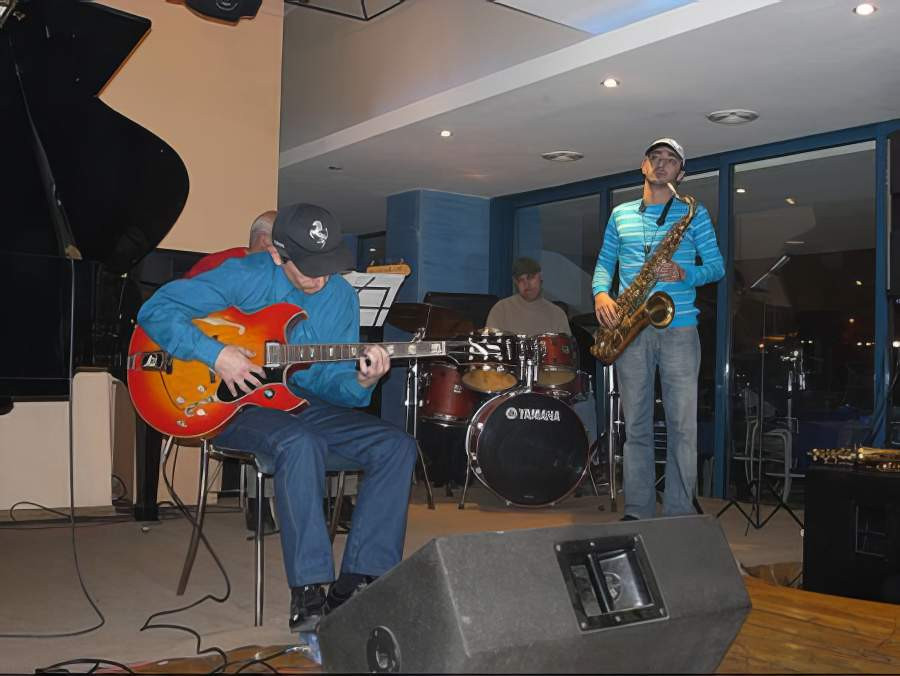
1 November 2009, evening, Claudia Badouin
4 NOV 09 Happy sun-worshippers with a bread cult
Faith carved in stone. The monastery of Geghard, about an hour’s drive southeast of Yerevan, is a unique focal point of Armenian identity. In the 12th century, Armenian nobles commissioned a church of amazing spirituality, hewn in the tuff at the end of the gorge of river Azat. Its architecture is that of the great period from the 3rd to the 7th century and makes it a monument to persistence, education and religion.

The legend accompanying the monastery leaves no doubt as to the Armenians’ immediate participation in the biblical history. It is called after the lance which is supposed to have caused Christ’s death on the cross and which is now one of the country’s relics. Gregory the Illuminator who warrants nearly all of the religious points of reference of the people is supposed to have founded it on a spring and source of a heathen cult. He and his predecessors have chosen wisely: at approximately 1500m above sea level and high above a river gorge, it is absolutely peaceful and quiet. The profane world is far away, locked out by steep and barren hills. Nothing distracts the attention from the contemplation of the essence of things – except maybe the wonderful craftsmanship to be seen on the columns, altars and cross stones.

Only a few kilometres away from Geghard, there is evidence that there must have been other things in this country characterized by scoring heat and freezing cold: a place of worship dating back to the 1st century. It is not clear why this Greek and Roman style column temple has survived as the only one cult site of the sun worshippers. The will to destroy of the ruling Christian has turned all of them to rubble. In Garni, this happened only during an earthquake in recent times, which in turn provided the Armenians with their “Hero of Socialist Labour”. Th e architect to rebuild it was honoured with this title.

This place of worship is situated in a cheerful spot, even if today the sky above the grass-covered hills around it is overcast. Protected from the wind, wine and fruit trees thrive on the slopes, and a Roman bath is a reminder of the good relation with Rome in these days. The masters of then used basalt and tuff as their building materials, and the Armenians of today would probably do the same, were it not cheaper to use concrete to put up the new flats in the centre of Yerevan for all the expatriate Armenians who hopefully will return …
But there is still something left of the good old times. Lavash, fresh from the oven deep down in the earth, the tonir, makes one forget the “prince” which is yet to come. The process of starting the fire with dry hazel twigs is already one fantastic spectacle. In a hut, we are grouped around the fire hole, excitedly watching the flames flickering high and wondering how bread can be baked in it. But when the ladies of the house take the initiative, matters get serious, dough is prepared from flour and water, extended with an experienced twist of the hand above the head to the famous 50cm by 100cm, spread out over a stable cushion, wetted and smashed with considerable slap against the wall inside the oven. Bubbles appear, a quick grasp downwards and a pitch, and the Lavash is dropping on a piece of cloth in front of the stunned guests. Within seconds, it is torn apart, filled with herbs and cheese, rolled into a wrap – and gone. The appetizer is quite a meal, and the subsequent starters with every the kitchen can provide are even more so, all of which is followed by the “prince”, Armenian trout from the grill, accompanied by potatoes.

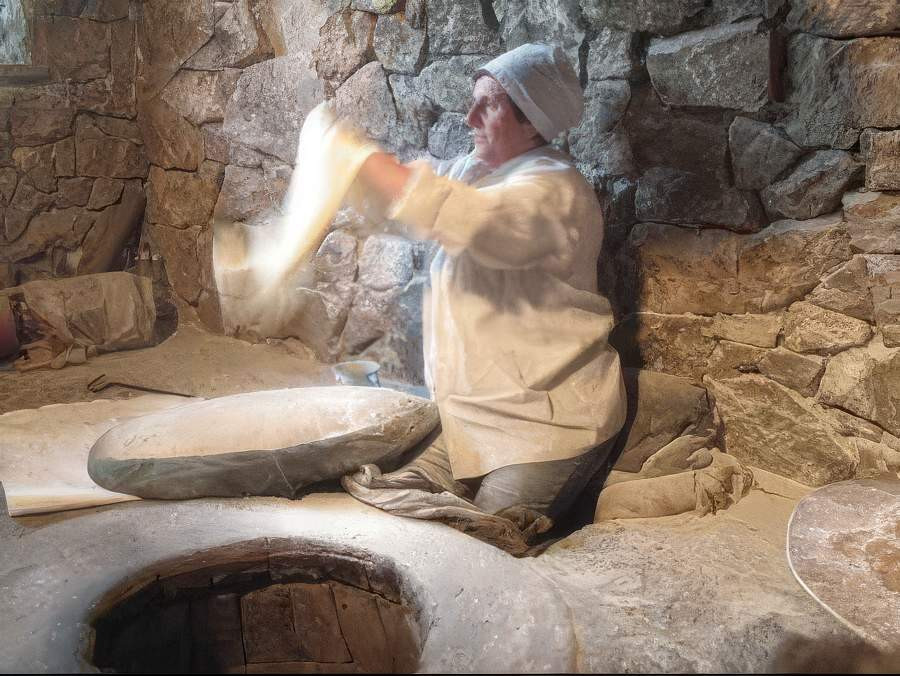
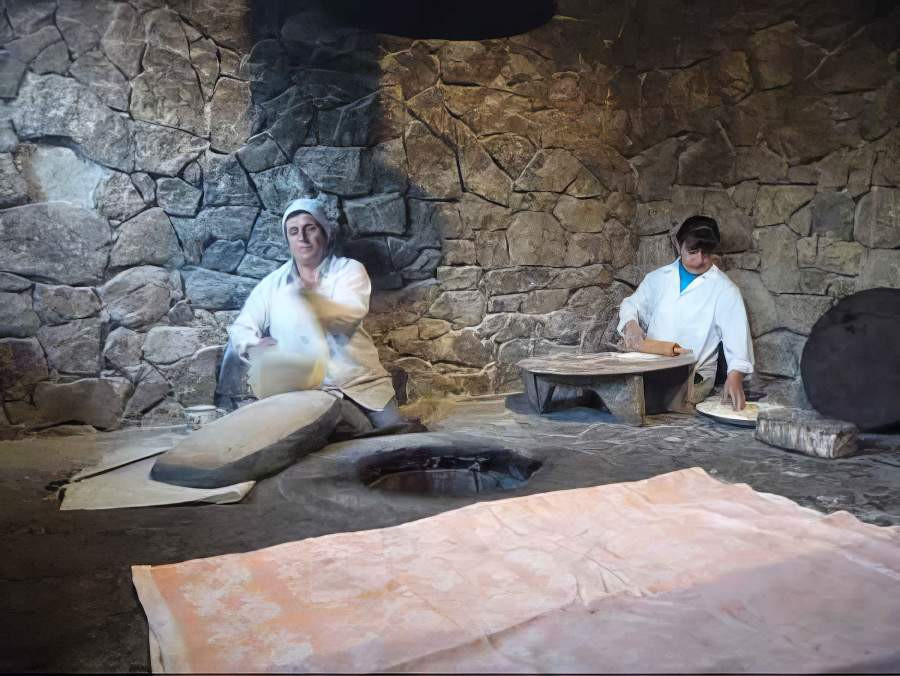


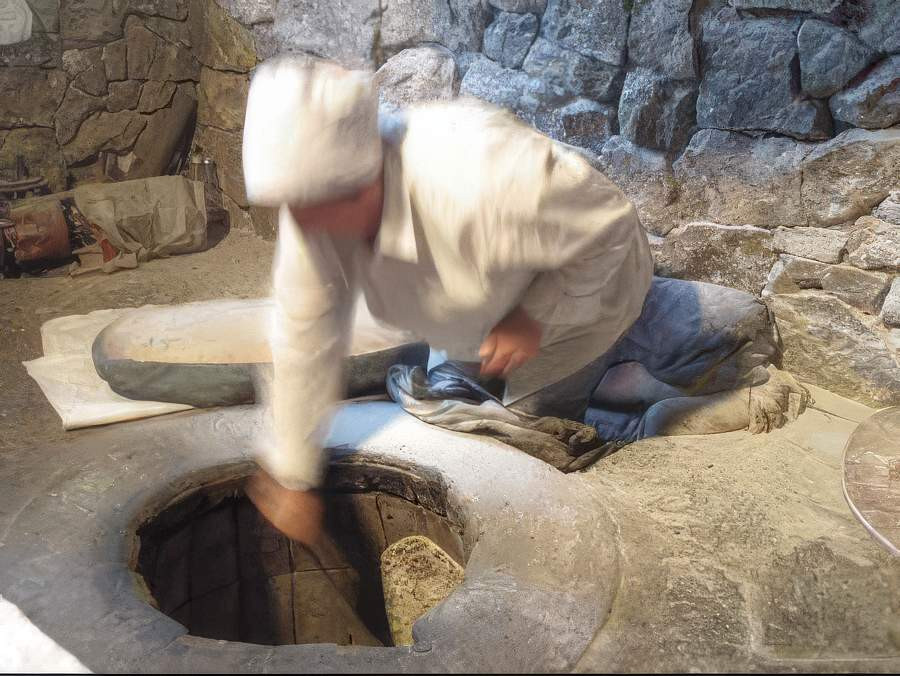
Way too much good food. On the bus we are in a sleepy mood, with some worries about the schedule. In principle, Mount Ararat is to our right, in principle, we are to listen to classic liturgical chants. But it is November and not the times of Komitas die Chazen, who once took care of the musical heritage. Drums and Hammond organ playing along with the Duduk, Kamantsch, Saz and Kanon would have been impossible for him to imagine. We, however, are richer for this experience.
3 November 2009, evening, Edith Kopf
3 NOV 09 Glance from the window: dry weather!
After two rainy there is a promise of sun. Some bits of blue sky are visible … Considering it’s Monday morning, the traffic isn’t too bad at 9:00 a. m.
During breakfast we (once again) discuss the recognition of the Armenian genocide 1914/15. Should German politics opt for the truth or for political “prudence”? Germany, or rather the German Empire, is at least partly responsible, may be even partly guilty. More than 3 million Turks in the Federal Republic, who might reinforce their opinion with Molotov cocktails? What would be the benefit – and for whom? Then we have to go to our bus, the days schedule is tight. The little white bus is already waiting for us in front of the hotel.

9:30 a.m. We’re visiting the graphics department of the Academy of Arts. Ara Baghdasaryan is waiting for us in front of the building: definitely Beaux Arts. As we are to learn later, there are close ties to the art school in Limoges. In the studio, there are two old etching presses and a lithography press, in a corner an “open system”.


In another building, to which we walk on little asphalt paths, up some stairs and past a few potholes, the teachers explain the course of studies with the help of final year projects: corporate design, icons and pictograms, signage systems – all of them displayed on charts sized 1m x 2,5m. A print this size costs approx. USD 100, which in relation to the purchasing power amounts to more than EUR 1.000. One work, a multifunctional electric vehicle for city cleaning from the industrial design class, might well pass for a project from our schools. It cannot, however, be created on one of the computers in the design department, which rather looks like a laying battery to me. Yet there is no time to ask many question. More (offical) information can be obtained under www.yafa.am.

Ascending the stairs to the main building, one catches a view of a façade giving a hint on how small the flats must be. Hakob, for instance, lives with his grandmother, his parents and his sister in a two-room apartment. Thankfully, the sister is hardly ever at home.
11:00 Sergej Paradjanov Museum. This is a structure in the style of residential buildings from a time when the city had no more than 20.000 inhabitants. It is located above the deep river gorge and opposite the football stadium with its gaily coloured rows of seats – a sign of hope after a football match between Turkey and Armenia. Someone living Munich might actually be familiar with the name of Paradjanov, since not too long ago, his movie The Color of Pomegranates (Sayat Nova) was shown there.
The museum is stuffed with odd collages, montages and assemblages, private mythologies, which also may read as a kind of defence against the pressure exerted by the Soviet system. Even while imprisoned, Paradjanov has collected all kinds of materials, even refuse like the tiny aluminium toppings of milk bottles, to tell his stories and create his relief thaler: poetic realism in dialogue with Tarkovsky, Fellini, Guerra and Pasolini.

13:00 (but really 13:30): Erik Ghabuzyan explains the development and the principle behind the Armenian alphabet – slightly difficult to follow, as everything needs to be translated and Hakob does not always know the proper technical terms. From time to time, Catherine joins forces with him and adds further explanations. In the meantime a little snack. Ghabuzyan is a trained mathematician and began 20 years ago to create fonts for scientific publications, quite like Donald Knuth did with TeX. In the cours of time, he built up an extensive library of Armenian fonts. In 2008, he founded the Armenian type design competition held every year. In 2012, Armenia will celebrate the 500th anniversary of the book, as the first book in Armenian language was printed in Venice in 1492 – years before the first printer started working in Armenia. Ghabuzyan is currently working for Adobe to design the Armenian versions of Minion and Myriad as well as for Microsoft to create an Armenian system font.

15:00: by bus we travel to see architect and graphic artist Fred Afrikyan. In his tiny office, we get to see hundreds of work samples and enter a time long by: book covers (he claims to have created more than 400 of them), drafts for medals and fonts, all in ink or gouaches on pencil and meticulously corrected with opaque white.

After that, he would like to introduce us to the architecture of his hometown, but it is impossible for the bus to stop anywhere. Upon arrival at the museum of architecture, we discover that it is closed, contrary to the opening hours and without any notice or additional information. So has to tell us in a windy corner that Alexander Tamanyans († 1937) and his disciples began their work in the 1920s and that their planning also included the huge stairs completed approx. 10 years ago leading to Mother Armenia at their top.

After a while he realises that this does not really make sense and says Good-bye. Time for a coffee until our next appointment. Left: Hakob Markosyan (27), our tour guide and translator; right: Fred Afrikyan (72), who calls himself a “real” Armenian.


18:00 Reception at the minister of cultural affairs, Hasmik Poghosyan. Exchange of official amenities, friendly, at ease. The minister is connected to Germany through a project with the literature workshop. The project may have been a starting point for her, too.
We have dinner in a Georgian Restaurant serving some meat-stuffed ravioli or pirogi as a delicacy. Hakob tells us about the tradition of the Armenian tamada, some kind of master of table ceremonies, and the custom of toasting. He offers one for the kids, keyword bed of nails. That might be a nice add-on to the Armenian wines that some friends of his are marketing in Germany. Maybe there is also this jam made of green nuts, or dried apricots from Armenia and other specialties, which we came to know here:
• Nari-Vertrieb
• Armenien-Shop
2 November 2009, evening, Gerd Fleischmann
3 NOV 09 Visit to the National Gallery
An extensive guided tour through the National Gallery of Armenia provides us with a first geographical and historical overview. The state of Armenia as of today is just a small fraction of the original settlement area. Even the rivers Euphrates and Tigris were part of it. Here is a map from the Soviet period.

31 October 2009, afternoon, Boris Kochan
2 Nov 09: Breaking unknown ground/2

A little park in between Yerevan’s town hall and Republic Square. (Post-)Soviet monumental architecture alternating with quiet spaces, a total of 2750 little fountains that were installed on a jubilee boulevard commemorating the age of the city, right next to it the “fridge gallery” of a street, and at the end of the walk the busy Republic Square and the adjoining National Gallery.

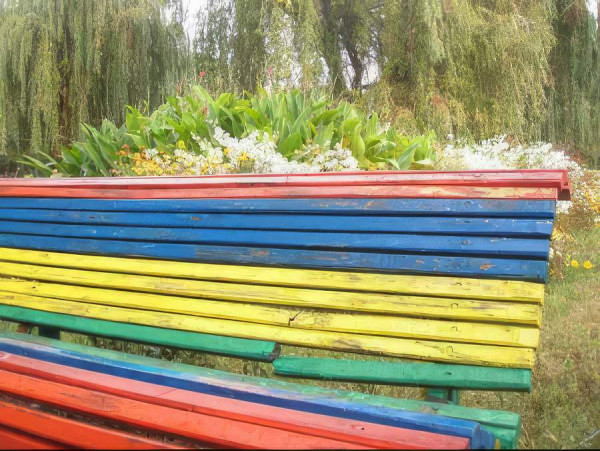



31 Oktober 2009, afternoon, Boris Kochan
2 NOV 09: Breaking unknown ground
It all seems rather far away from everything, right now, in the middle of the night. Why on earth does Austrian Airlines fly by night into the night, against time, on their service to Yerevan? The rows of seats are very close to each other, following the minimalist British Airways standard, and the air is incredibly stifling, hot and sticky. Arrival is scheduled in between 3 and 4 a.m.
Tiredly staggering down the Gangway of Yervan’s Swartnoz Airport. This is all very shiny and new and apparently follows the international impersonal airport design – at least, if my tired eyes don’t play tricks on me. Very efficient border guards quickly realized that they are confronted with a group of travellers and they collect 21 passports, which have to redeemed by visa fee of 3000 DRM per person (payable in the national currency only). After that, the way through customs is easy, and at the exit Catherine Avak, who has organised the trip and has arrived a couple of days earlier, is overjoyed to welcome us. We are in her country.
As soon as we leave the airport, the scenery changes abruptly: exit the cool and shiny facades, and enter the busy early-morning taxi traffic. In the background, there is a dimly visible construction site with many concrete skeleton frames reaching for the sky. Slight rain.
31 Oktober 2009, early morning, Boris Kochan
2 NOV 0 9: tgm study trip to Armenia 30 November to 7 December 2009
So this is Paradise Lost! Noah’s Ark landed on Mt. Ararat, the holy mountain of the Armenians. Here, in the city of Yerevan, many important caravan routes intersect: the country of Armenia is a geographic, cultural and political crossroads between Europe and Asia, between Christianity and the world of Islam.
One of the oldest cities in the world, Yerevan is probably represents Armenia’s path between renewal and conservation. In the “pink city”, thousands of historical buildings are to be seen next to many little galleries: the Cafesjian Museum Foundation presents contemporary art in a modernist building; the “Hay-Art” continuously hosts exhibitions on the interactions of Eastern and Western art; an entire museum dedicated to the painter Martiros Saryan; the Erebuni Museum in the city’s fortress; the Museum of Popular Arts; an international film festival … the city is highly interesting in many respects.
In this new blog by the Typographical Society Munich a small band of travellers will write about their experiences and impressions during their journey through Armenia.
Weitere Blogbeiträge, die Sie interessieren könnten
Cairo – Navigating Communities
From October 28 to 29, the international Granshan Conference 2016 took place in Cairo under the auspices of the American University Cairo (AUC) and organized by Kochan & Partner and the Bibliotheca Alexandrina Calligraphy Centre. It was preceded by two days of workshops.
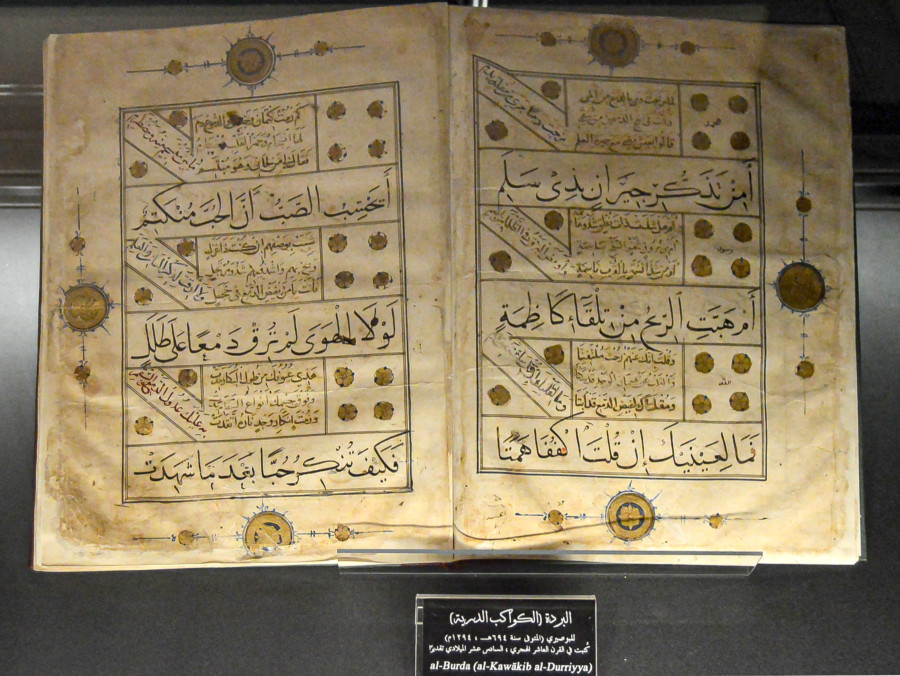
Jerusalem, zweiter Tag
Das Österreichische Hospiz, in dem die meisten von uns übernachten, liegt mitten in der Altstadt und ist eine wunderbare Oase der Ruhe, etwas burgartig gebaut. Frühmorgens hört man die Hähne krähen oder den Muezzin rufen, je nach Lage des Zimmers.
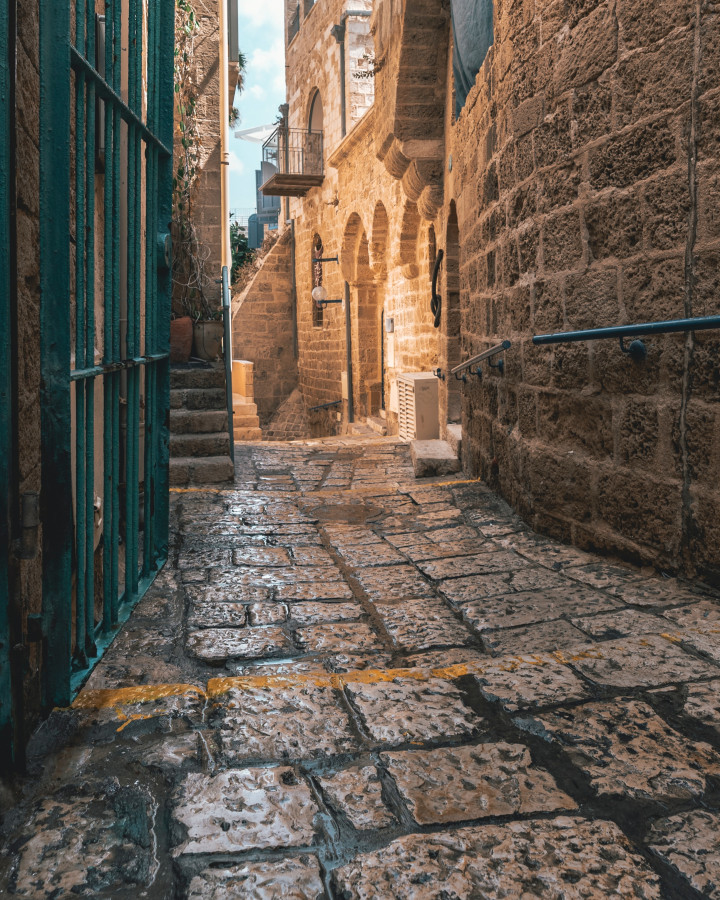
Streifzüge ins Neben
Zwei Teilnehmerinnen unserer Reise nach Paris geben uns einen Eindruck von der Vielfalt und der Dynamik dieser Reise. Gabriele Werners lässt in ihrem Bericht die vielfältigen künstlerischen und kulturellen Erfahrungen der Teilnehmer lebendig werden, Judith Häusler zeigt in ihren Fotos u.a. Kunst, Begegnung und Inspiration in den Ausstellungen von Joseph Beuys und Anselm Kiefer.

GRANSHAN 2011
Mit der Konzentration auf die Kategorien Armenisch, Kyrillisch und Griechisch ist GRANSHAN weltweit der einzige Schriftwettbewerb, der die Entwicklung nicht-lateinischer Schriften fördert.


